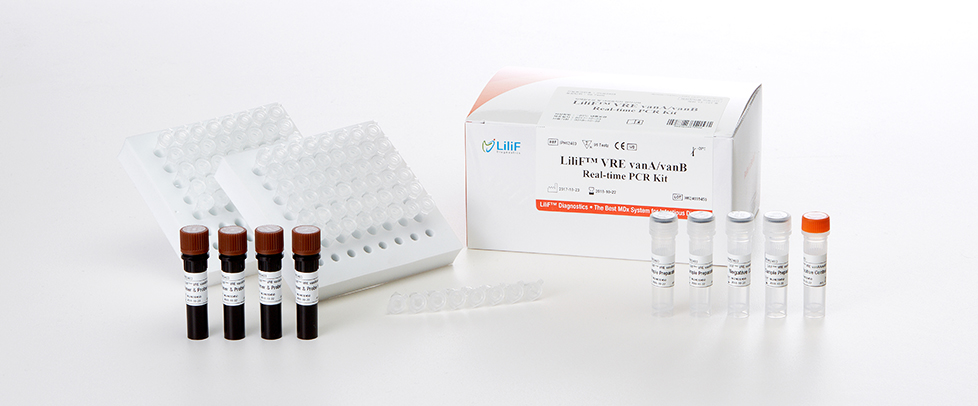LiliF® VRE vanA/vanB Real-time PCR Kit

Enterococci are a group of gram-positive, round-shaped bacteria that commonly live in the gut, although they can cause infection anywhere in the body. They are resistant to several antibiotics, but in the past, physicians could rely on the drug vancomycin to effectively treat enterococcal infections. Vancomycin is a drug that has an antibacterial effect by forming a complex with the D-alanyl-D-alanine terminal of the peptidoglycan precursor to block transglycosylation and transpeptidation during the synthesis of the cell wall of Gram-positive cocci. vancomycin-resistant enterococci (VRE) tend to multiply rapidly due to the high frequency and continuous use of vancomycin.
In the United States, according to data f rom NNIS (National Nosocomial Infections Surveillance) the percentage of nosocomial enterococci resistant to vancomycin increased f rom 0.3% in 1989 to 7.9% in 1993. The CDC (Centers for Disease Control) reported that VRE in US hospitals had shot up f rom 0.3 percent of all enterococci in 1989 to 7.9 percent in 1993. In some hospitals, the percentage was closer to 14 percent. By the mid-1990's, the mortality rate for patients with VRE had climbed to more that 40 percent.
Three glycopeptide resistance phenotypes in Enterococci can be distinguished on the basis of the level and inducibility of resistance to vancomycin. The vanA type is characterized by acquired inducible resistance to both vancomycin, and the vanB type is characterized by acquired inducible resistance to various concentrations of vancomycin. vanC-type glycopeptide resistance is characterized by constitutive low-level resistance to vancomycin and is an intrinsic property of E. gallinarum, E. casseliflavus, and Enterococcus flavescens.
To become VRE, vancomycin-sensitive Enterococci typically obtain new DNA in the form of plasmids or transposons which encode genes that confer vancomycin resistance.
Rapid and accurate identification of VRE is crucial in the management and treatment of both colonized and infected patients, to allow selection of appropriate antimicrobial treatment and to prevent the spread of VRE by implementing appropriate infection control procedures. Culture-based screening methods for VRE are typically time-consuming and can take f rom 1 to 5 days to complete. Molecular methods based on polymerase chain reaction (PCR) using a rapid VRE screening methods have been tried.
Infection with VRE typically follows vancomycin-resistant enterococcal colonization, predominantly of the gastrointestinal tract. Colonization, which does not result in symptoms, may last for long periods and may serve as a reservoir for the transmission of VRE to other patients. Within hospitals, widespread colonization with VRE may occur with a comparatively small number of documented infections. VRE can cause different problems depending on where in the body the bacterium is present. According to the VRE can colonize the intestines or urinary tract without causing disease. However, if the bacteria flourishes in the urinary tract it can cause an infection there called a urinary tract infection (UTI). In addition, if the enterococcus spreads to other parts of the body, it can cause an infection there, too. In addition to UTIs, VRE is known for causing bloodstream infections and wound infections. VRE may also be introduced directly into an open sore or wound, causing a wound infection. The bacteria produce several substances, including proteases that help them break down the normal barriers between the gut tissue and the bloodstream.
VRE are resistant to a wide array of antibiotics. Fortunately, newer antibiotics have been developed to bridge this gap, but sometimes they must be used in combination with other antibiotics.
LiliF™ VRE vanA/vanB Real-time PCR Kit detects the vanA and vanB genes which cause vancomycin-resistance in enterococci isolated f rom stool culture in a single test. This kit consists for abnormalities of PCR with internal control to validate triplex. This accumulated fluorescence is detected the 3 signals, FAM, HEX and Cy5.
LiliF™ VRE vanA/vanB Real-time PCR Kit is a convenient PCR master mix containing Taq DNA Polymerase, dNTPs, reaction buffer, tracking dye, and patented stabilize. According to the experimenter raised the risk of error is low and the high reproducibility can be drawn over. In addition, the cultivation of various types of samples (EB broth, EA plate, BHI broth), as well as possible f rom the analysis of genomic DNA extracted directly f rom stool analysis are easy targets.
The LiliF™ VRE vanA/vanB Real-time PCR Kit is a PCR method that Taqman chemistry with high sensitivity and specificity, and is a product that can test for the vancomycin-resistant vanA gene and the vanB gene of enterococci in one test.
• LiliF™ VRE vanA/vanB Real-time PCR Kit uses PCR and Taqman chemistry. During PCR reaction, reaction product is amplified with specific primers of vancomycin-resistant Enterococci vanA and vanB DNA region. Simultaneously, specific Taqman probe is broken down and fluorescence is accumulated. This accumulated fluorescence is detected by real-time PCR cycler. It shows higher specificity than conventional PCR method because of simultaneous use of primer and probe. Also, it shows better sensitivity than conventional PCR owing to Taqman chemistry.
• This kit is purposed in vitro diagnosis to selective screening and qualification for vancomycin-resistant enterococci (VRE) and vanB genotyping f rom stool or Enrichment culture using Real-time PCR method.
| No. | content | 96 tests/kit |
|---|---|---|
| 1 | Sample Preparation Solution | 1.7 ml x 3 tubes |
| 2 | 2XPCR mixture | 96 tubes |
| 3 | Primer & Probe mixture | 140 μl x 4 tubes |
| 4 | Positive Control | 100 μl x 1 tubes |
| 5 | DNase/RNase Free Water | 1 ml x 1 tube |
| Product | Cat.No | Capacity | inquire | |||||||
|---|---|---|---|---|---|---|---|---|---|---|
| Patho Gene-spin™ DNA/RNA Extraction Kit Best |
|
|||||||||